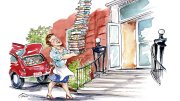In 1979, a team of psychologists posted themselves at several stop signs in suburban New York and tabulated the behavior of the drivers who approached them. Thirty-seven percent of all drivers came to a full stop, 34 percent made rolling stops, and 29 percent did not stop at all. Over the course of the next 17 years, the observations were repeated ?ve times. By 1996 those making full and rolling stops had declined to only 3 percent, while everyone else drove through the stop sign.
If you believe that Americans have become more preoccupied with themselves and less likely to cooperate with others, the behavior of these drivers offers convincing proof. Two aspects of the study were unusual. The ?rst was that the researchers measured actual conduct—not, as in surveys, the ways in which people describe what they believe. And the other is that the study was repeated often, enabling us to compare behavior at one time with the same behavior at an earlier period.
Alas, not all social-science research is as de?nitive as the stop sign study (and even that study raises questions of how one accurately differentiates between full stops, rolling stops, and no stops). Robert D. Putnam, the Stan?eld professor for international peace at the Kennedy School of Government, suggests an answer to the question of how we can draw conclusions about people’s behavior when each study of how they behave is incomplete. Gather as many as one can, he suggests, put them all together, and if the great bulk of them point to the same conclusion, we can begin to trust that the conclusion is correct. That, in a nutshell, is what Bowling Alone tries to do as it explores the question of whether Americans have lost a sense of togetherness.
Putnam’s book is an elaboration and extension of his 1995 article of the same name from the Journal of Democracy. In that article, one of the most widely cited pieces of scholarship ever published in the social sciences, Putnam suggested that America has experienced a decline in “social capital.” Just as industry needs to reinvest in new equipment and as people require investments in education and healthcare, society runs better when its institutions encourage trust and cooperation. “Bowling Alone,” the article, assembled such data as membership in voluntary associations like parent-teacher associations and the Boy Scouts, and responses to survey questions dealing with whether Americans trust each other, to argue that social capital was indeed being depleted in America.
In book form, Putnam has more than 300 pages, rather than 30, at his disposal. He also has in hand the verdicts of his critics, one of whom, the late Everett Carl Ladd, published an entire book attacking Putnam’s ?ndings. The publication of his own book therefore offers Putnam the opportunity to close the door on the subject by demonstrating that, when all is said and done, the overwhelming bulk of the evidence supports his thesis.
Let it be immediately said that Putnam’s exhaustive survey of just about every study that touches in any way on his topic is not only valuable, but does suggest that American society has been fundamentally transformed in the past 30 or 40 years. Take civic participation, for example. Putnam reviews the responses people have given to survey questions about the organizations to which they belong and—although surveys measure what people say rather than what they do—he shows that, despite different methodologies, all of them point in the same direction. “That they converge so closely in their estimate that active involvement in local organizations fell by more than half in the last several decades of the twentieth century is as striking and persuasive,” he writes, “as if southwestern tree rings and Arctic ice cores and British Admiralty records all con-?rmed the same rate of global warming.” Much the same can be said for church attendance, union membership, card playing, and, of course, participation in bowling leagues, all of which can be tracked along similar downward slopes.
Some of Putnam’s critics have pointed out that the one exception to the trend of Americans becoming less engaged was religious organizations. Not so, Putnam responds. True, there has been an upsurge in membership in evangelical Protestant denominations, but evangelicals search after spiritual ful?llment, not community involvement. Similarly, in response to those who argue that people are now more civically engaged in their workplaces, Putnam cites countertrends to the effect that workplace environments, in an era of downsizing, are more competitive and less cooperative. To those who claim that there has not been any diminution in the degree to which Americans engage in voluntarism, he shows that the important trends are generational: the older generation, which is civically conscious, still volunteers, but younger people have slacked off, which suggests that “volunteering that requires a younger constitution, such as ?ghting ?res or giving blood, is down.” Putnam even takes on those who suggested that the whole idea that people “bowl alone” is wrongly conceived, for if bowling leagues have fallen off, informal bowling continues apace. People still get together with others, Putnam says, but they do so to be “schmoozers”—people who meet sporadically, mostly for the enjoyment of it—rather than “machers”—people who get together with others in order to get things done.
With more pages at his disposal, Putnam is also able to go into considerable detail about the causes of social capital’s decline. He explicitly rejects the entrance of women into the labor market as a factor because full-time employment has actually enhanced the civic participation of many women. Mobility and suburban sprawl are also not responsible. Pressures of time and money play a “modest” role. As in previous versions of his argument, Putnam assigns the greatest share of the blame to television: “Americans at the end of the twentieth century were watching more TV, watching it more habitually, more pervasively, and more often alone, and were watching more programs that were associated speci?cally with civic disengagement (entertainment, as distinct from news).”
After reading the evidence assembled in Bowling Alone, no one, it seems to me, can take serious issue with the fact that Americans are less likely to become joiners than they once were. But does this mean that their social capital is depleted? The most impressive new research Putnam offers in support of his thesis is the development of a “social capital index” based on rates of volunteering, voting turnout, and a willingness to trust others. He reports that states like Minnesota and North Dakota rank high on social capital, while Mississippi and Arkansas rank low. He then examines measures of child welfare, safety, health, tolerance, and prosperity, and ?nds that states with social capital are more likely to rank high on those as well. The greater the civic involvement, he suggests, the greater the possibility that people will live up to their full human potential.
Still, the same question that nags the reader of the article nags the reader of the book. Of course civic life has changed; how, in a dynamic and entrepreneurial society, could it be otherwise? To use the language of decline, as Putnam so often does, is to suggest that people at one period of time were somehow better than at another period of time. That is a questionable assumption. My mother and father joined lodges, played cards, belonged to a cooperative swim club, and lived very close to their brothers and sisters. I live in a town 200 miles from the place of my birth, work too many hours each week, am married to another college professor who also works long hours, and our nearest relatives are a thousand miles away. There is no question in my mind that my life is richer in every way than the life my parents ?ed in order to move to Florida the moment they could retire.
If my experience is at all typical, Americans have lost community but gained opportunity. Each is valuable, but I know of no social-science research that can prove that one is more valuable than the other. Putnam acknowledges these things. His book includes a chapter on the “dark side” of social capital, such as the conformity often reinforced by strong community life, but in that chapter, and elsewhere, the most he will do is qualify his thesis, and then only marginally, rather than rethink it. I wish Putnam had simply deleted terms like “decline” or “collapse” from his vocabulary so that the story of the transformation in American life would emerge on its own, with all its complexities and ambiguities built in.
Because Putnam is so convinced that the story he has to tell is a story of decline, he concludes his book with a section on how civic life can be revived. It is a very weak conclusion to an otherwise strong and impressive book. “Our challenge now is to reinvent the twenty-?rst-century equivalent of the Boy Scouts or the settlement house or the playground or Hadassah or the United Mine Workers or the NAACP,” he writes, referring to the explosion of civic associations formed during the Progressive period. To get us there, Putnam assumes the role of a preacher: “Let us spur a new, pluralistic, socially responsible ‘great awakening,’ so that by 2010 Americans will be more deeply engaged than we are today in one or another spiritual community of meaning, while at the same time becoming more tolerant of the faiths and practices of other Americans.”
I do not believe that Putnam’s skills as a social scientist are matched by a similar talent in moral exhortation. “Naming this problem,” he writes of America’s loss of social capital, “is an essential ?rst step toward confronting it,” citing the examples of Betty Friedan and Rachel Carson. Whereas those writers, blessed with literary skills, did indeed—as Putnam puts it—“name” an era, I doubt whether Putnam’s “agenda for social capitalists,” as he awkwardly calls his conclusion, will rise to that level. Putnam’s earnest conclusion sounds more like a presidential State of the Union address than a ringing call to arms. And that is perhaps as it should be, for if social capital is ever expanded, it will be because of what people do, not because of what social scientists tell them they ought to do.
It is to his credit that Robert Putnam has demonstrated so effectively the role that social scientists can play in framing issues with which our society needs to wrestle. He has gone to painstaking lengths to gather data whose meaning we all need to ponder. But to do so effectively, we also need to keep in mind that most social-science research, de?nitive as it may be in examining whether or not we stop at stop signs, can tell us only so much about how moral or immoral we are.





